I had a chance to do a head to head test of the Keto Mojo blood ketone meter and the Biosense breath ketone meter during my recent 8-day water fast.
I tested my blood and breath ketones using both multiple times throughout the day. My impression is below.
First, a quick reminder on why I planned to switch to Biosense:
- Less cost: break even at 300 tests, $1.00 per test savings thereafter
- Better accuracy: clinically proven precision vs “within 20%”
- No finger pricking
- Faster: I expected the time to blow and wait for results would be faster than pulling out my gear, pricking, taking a blood drop, and waiting for results
- More convenient: Traveling with all my gear and storing extra strips isn’t a huge deal but I was excited to just slip the Biosense in my purse and be done with it.
Unfortunately, many of my expectations didn’t quite match reality after I was able to try the device.
Update!! This article is being updated January 2021 using the NEW keto mojo. Many of the shortcomings of the older version have been addressed.
Here’s how the Biosense compares to my new Keto Mojo on factors of:
Or skip straight to the bottom line.
One quick note: The Biosense measures ketones using a unit called ACEs. 10 ACEs is roughly equivalent to 1.0 mmol/L of BHB blood ketones. 20 ACEs on Biosense roughly equals 2.0 on keto mojo, 30 ACEs approximates 3.0, etc. Just move the decimal point space to translate.
Finger Pricking: Advantage BioSense
The Biosense has the clear advantage here. For people like my sweet husband Brad who hate needles and blood, a breath meter really is the best solution, and Biosense is the only breath meter out there with clinically proven accuracy. In fact, I expect Brad to be the primary user of our Biosense.
However, if you’re tracking your GKI for therapeutic ketosis and not just your ketones, you’ll likely still need to prick for the glucose test. The alternative, which I’ve tried, is a continuous glucose monitor (CGM). A CGM only needs to be inserted every two weeks and will send 8 hours of recorded data to my phone via Bluetooth with just a tap.



Most of the time I’m not wearing a continuous glucose monitor, though – and most therapeutic ketoers aren’t either. Instead, I’m using the Keto Mojo as my blood meter and can use the same drop of blood for measuring my ketones, too.
Biosense is therefore generally best in the finger-pricking department for those who are only tracking ketones and not GKI.
Cost: Advantage KetoMojo
Even though the up-front cost is substantially higher, there’s no incremental cost per test with the Biosense. The new Keto Mojo has less expensive strips – less than $0.95 for per ketone AND glucose strip. With Biosense, a separate glucose monitor and strips must be purchased in order to monitor GKI.
| Biosense | Keto Mojo | |
|---|---|---|
| Meter Cost | $299 | $110.97 (comes with 70 keto strips and 70 glucose strips) |
| Cost per ketone test (per strip) | $0 | $0.80 |
| Cost after 300 tests | $299 | $295 |
Time to Test: Advantage Keto Mojo
Ohmygod the Biosense takes so long to test. Over two minutes of noisy “preparing the device” before each test. Then usually 10 seconds to blow and sample, then 20 more seconds to analyze and display the results.
IF it doesn’t automatically start “deep clean” mode which takes well over 5 minutes. After my first day of testing I was in deep clean mode every time.
Note that, you only have a 2 minute 15 second window after “preparing the device” in which to test. If you get distracted and miss that window, you will need to wait over 2 minutes to prepare the device again. At my most focused, each test took 3 minutes.
Keto mojo takes 7 seconds to charge after insertion of a test strip. I usually prick during that time. Less than 5 seconds to register my blood drop and 10 seconds for results.
| Biosense | Keto Mojo | |
|---|---|---|
| Time to charge | 135 sec or 305 sec with deep clean | 8 sec |
| Time to sample | 9 sec | 4 sec |
| Time for analyze | 20 sec | 10 sec |
| Total test time | 164 – 334 sec | 22 sec |
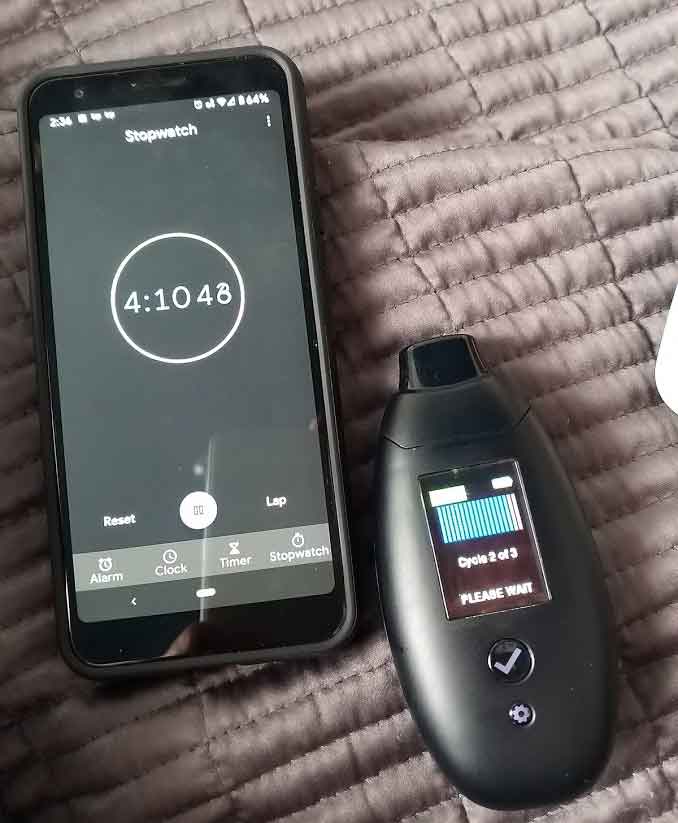
Convenience: Debatable
The Biosense has less to keep track of, which is nice. Just the device itself in its small carrying case if I’m going out for the day. To conduct a test on the Keto Mojo I need the device, strips, and the lancet for pricking, all of which fit in the slightly larger carrying case.
What I didn’t take into account with the Biosense was the fact that it needs to be charged so I need to keep track of it’s micro USB charger. It’s a little more brain space for my nomad life living out of a suitcase and adds the risk of running out of battery.
This could just be a problem with my limited mental bandwidth. The Keto Mojo requires keeping track of strips, the lancet, and backup lancet needles so pick your poison.
Really, it’s just the time investment and noise involved in Biosense testing that keeps me reaching for the Keto Mojo.

Accuracy: Debatable
Precision: Advantage Keto Mojo
Biosense actually paid for a clinical trial demonstrating its accuracy and I give them points for that. However, a deeper look at that research doesn’t show that it is necessarily more accurate than Keto Mojo. The results of their small trial (19 people) showed that Biosense results correlated strongly with blood meter results. That is to say, they were similar. Interestingly, breath ketone numbers seemed to lag behind blood numbers.
However, I have a real concern with my experience using the Biosense.
Biosense vs Keto Mojo: Precision and Repeatability
The biosense’s readings varied A LOT over the 3-5 minutes it takes to take a repeat reading. From 32 to 40 within 5 minutes and 39 to 25 within 3 minutes… keep in mind that these were all taken after 2 days of water fasting when multiple readings on my keto mojo were showing the same steady, repeated numbers when these readings were taken.
Biosense vs Keto: Mojo Accuracy
Legally, Keto Mojo readings are within 20% of your actual blood glucose. Frequently, Biosense readings differed from the Keto Mojo by more than 20%. Obviously, the truth could be somewhere in-between but it did raise some concerns on my part given that the Biosense differed from its own readings by more than 20% sometimes, as shown above.
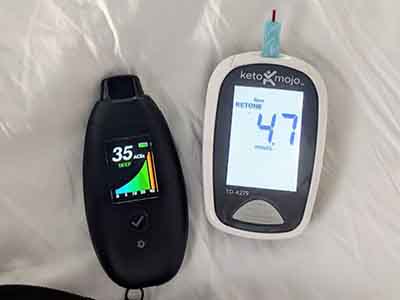
Technology: Advantage Keto Mojo
The Biosense comes with a nice app that makes pretty charts, which I like a lot. The device does become untethered from the app seemingly every test but it’s easy to re-tether and I’ve never lost data.
The new keto mojo also comes with an app. Best of all, because the device tests both glucose and ketones, it will automatically calculate GKI, which is kind of huge.
Both devices integrate with Cronometer, the online tool most therapeutic ketoers use to track their eating and metrics.*
* Note that, device data must sync to the Biosense app before it is imported to Cronometer – usually a half day delay or so.
Usefulness: Advantage Keto Mojo
I wasn’t sure what to call this section but the fact is that the Biosense isn’t that useful to me because it doesn’t measure ketones over 40 ACEs, the rough equivalent of 4.0 mmol/L BHB ketones.
Those using keto for medical, therapeutic reasons — especially those targeting GKI less than 1.0 — are usually over 4.0 ketones and need to know how much over to know if their GKI is less than one. The Biosense 40 limit tells you you’re under 1.0 GKI only if your blood sugar is under 72 mg/dL.
Honestly, I’ve maxed out the 8.0 limit on the keto mojo once before but going over 8 mmol/L of blood ketones is incredibly rare and not advised.



You can see how, for me, the straight line chart showing that my ketones measured as ACEs are over 40 is less helpful than knowing when they’re higher or lower in this range.
The Bottom Line: Keto Mojo vs Biosense
Biosense is best for:
- People who are pursuing nutritional ketosis and don’t often need to measure ketones over 4.0.
- People who hate the finger prick
- People who don’t need to track glucose-ketone index for therapeutic ketosis.
If this is you, click here for $20 off Biosense! (note that the discount only displays during checkout.)
Keto Mojo is best for:
- People pursuing therapeutic ketosis who spend much of their time in the 4.0+ ketone range.
- Those tracking GKI without a CGM who have to prick anyway.
- People who don’t mind the finger prick.


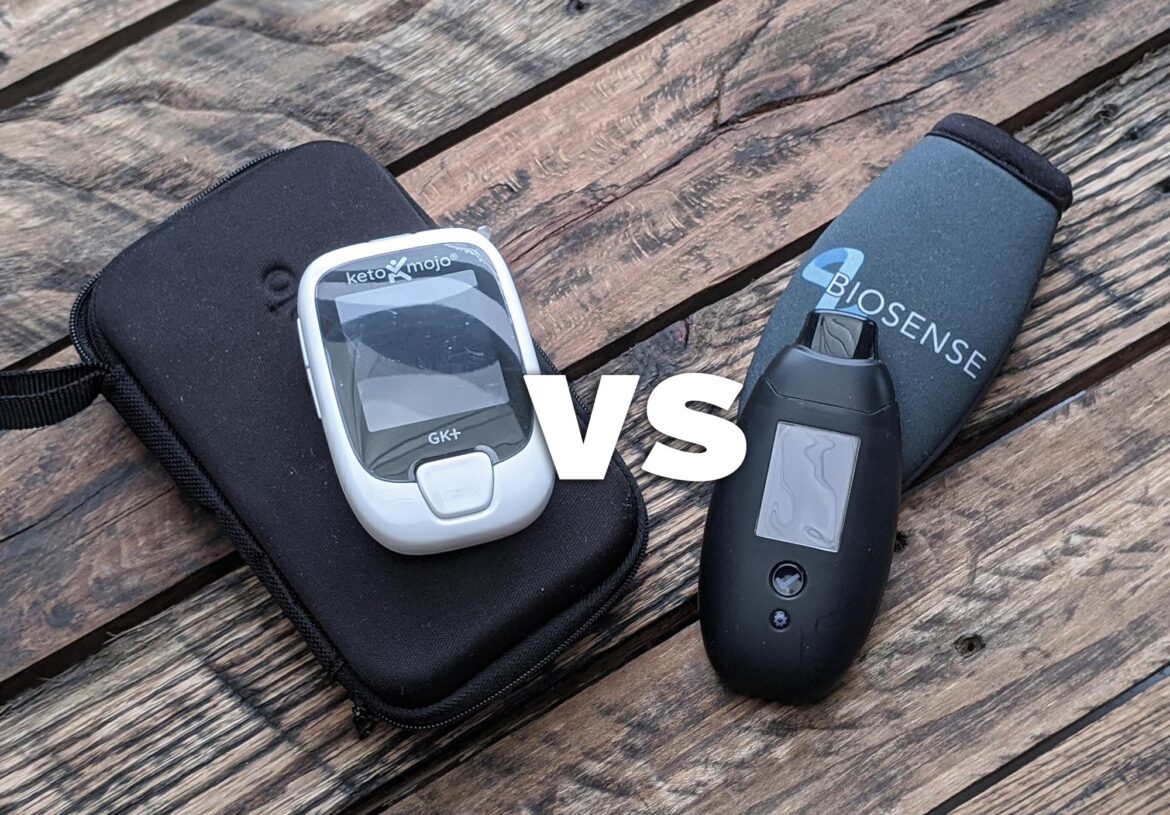


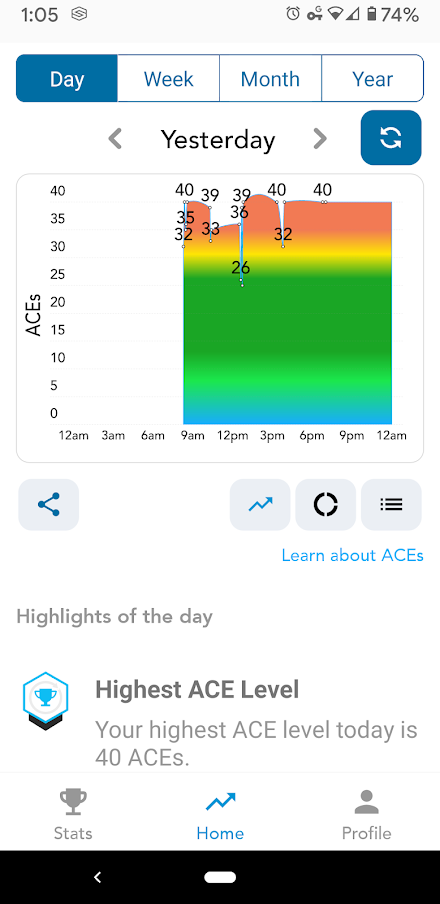
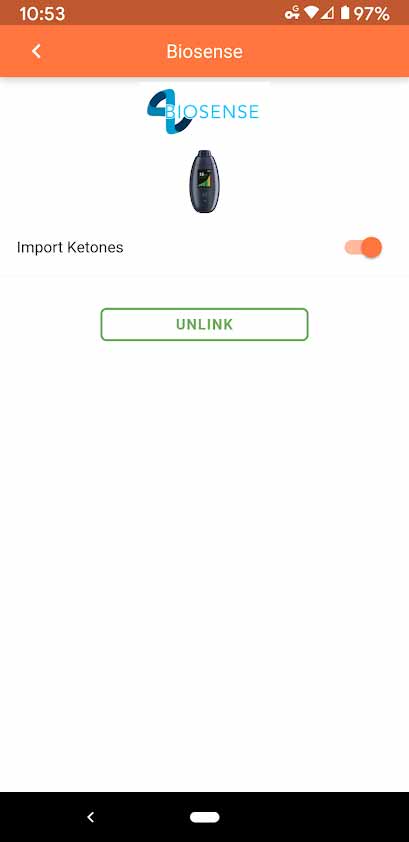
14 comments
Thanks for your blogs Maggie and glad you are doing well health-wise! Did you reach out to Biosense to see if you have a flawed device or is this standard isuses as far as you can tell? Regarding accuracy, app linking and time to startup and test?
Hi Rob! Great question!
I’ve heard they’re actively working on improvements and the device they sent me is a little older. I can’t vouch for the latest improvements, though, since I haven’t tried them. As far as accuracy, the Biosense does test for a different type of ketone. Blood tests test for BHB and breath meters for acetone so it’s possible I had higher BHB than acetone. I realized after I took some exogenous BHB ketones and it didn’t budge my Biosense readings.
To be honest, after about a month transition time I’ve gotten a lot more used to using the Biosense and tend to reach for it more often than my keto mojo these days. The noise doesn’t bother me as much and instead alerts me when it’s ready for testing so it doesn’t feel like it takes quite as long. I’ve heard from some other folks that the 2-5 minute prep time is pretty standard.
Thank you so much for the kind words, too!
I am disturbed that all the cost comparisons that I see for Biosense infer that the device runs forever. I believe I heard their Product VP say in an interview that the cartridge is good for about two years. $300 every 2 years is not a savings.
Oh Sharvo! This is such great information. Thank you! I’d never heard that the Biosense only has a 2 year lifespan. I’ll check with the company but, in the meantime, it still makes sense for me to update the article to take this into account. Since I test multiple times per day and the biosense breaks even after 250 tests, it’s still a significant savings for me (two years would be over $1500 in test strips for me). Nevertheless, it’s a critical point for folks deciding. Thank you again!
Keto-Mojo has an app too. It syncs via Bluetooth and pulls in readings. It figures you GKI for you. The data can be exported as well.
Yes! The new version has so many bells and whistles! I just got mine and can’t wait to try it and update this article!
So glad to have found your site and thank you for the informative review. I think the breath meter would work well for me because I am a carnivore so I have reliably low boring and steady blood sugar so I don’t really need to measure it. I can see that if you were sticking your finger anyway for one you may as well do both at once with the MoJo.
I’m a fellow cancer survivor taking my health and future into my own hands too. I look forward to reading more of your story.
Hi Robin! Carnivore is such a perfect use case for the Biosense! And you’re exactly right that when I was wearing a CGM and didn’t need to prick, I’d usually just blow. My glucose is the best determinate of my ketones, anyway. Sending you tons of love on your journey!
Hi Maggie, thanks for pointing me to this updated article! Loved your thorough breakdown of each potential consideration. This was so helpful. Your health journey is certainly invaluable to others and I’m thankful your’e doing well!
I have had my share of health complications and love helping others fight a battle that we can win, and metabolic therapy is amazing! I’m currently eating carnivore and tracking my GKI is for learning / biohacking purposes only – but will be good information to be able to apply in the future. I have two other questions you probably have outlined somewhere on your site:
(1) When and how often do you recommend testing GKI? Is there a standard for this?
(2) Also, I do medium / long water fasts (10 days) and I noticed your statement: “going over 8 mmol/L of blood ketones is incredibly rare and not advised” – I’m very low body fat (6%) and wonder if I can / should use a metric such as this to help me identify if I’m fasting too long? I have never completed a FULL fast where my body tips into starvation mode and cues my that it’s time to eat, but I would imagine at my lower BF% that I may not make it past 20-25 days? Would love your thoughts or recommended reads on this.
Again, thank you so much!
Subscribed!
Thank you so much for the kind words! To answer your questions:
1. Sadly, there’s not a lot of research or scientific recommendations on when or how often to test. But you totally guessed right that I have a ton of my own thoughts at https://cancerv.me/2019/10/25/the-complete-guide-to-glucose-ketone-index-gki-tracking-for-therapeutic-ketosis/
tl;dr: I think 1-2x per day beginning the diet, then every few days if your diet doesn’t change just to be sure there are no surprises. I like a pre and multiple post-prandial tests when introducing a new food and at least a few days with very frequent tests to understand your personal rhythm.
2. Oof. So, with the whole disclaimer that I’m not a medical professional, talk to your doctor and all that… I don’t really know but do think that ketones could be a good measure. Glucose is probably even better. My first extended fast I was quickly with GKI <0.5, which I think would be a fasting limit for me now. These days (on lots of steroids) I can't get under 1.0 after 7+ days. Ultimately, listening to your body is the most important thing, of course, but I definitely wouldn't advise over 7 days at your low body fat. 3-6 days is my sweet spot. I actually just interviewed Dr. Valter Longo of USC who pioneered fasting research last month and he doesn't like more than 3-5 days. If you're aiming for 20-25 days, I'd recommend breaking it into multiple 5 day fasts with a refeed in between. Always with your doctor, of course =D Ultimately, you know you best, though.
So good to meet you, Tyler!
Dear Maggie,
Thank you so much for your previous response. If you would be willing to answer another question via this format, here it is:
My ND who is very accomplished as it comes to breast cancer has this to say about keto:
the meat based version can cause a lot of acidity in the body and raise IGF1 and both versions are leaving out important nutrients (that are important for estrogen metabolism) that we get from fruits and beans.
She also gave me these numbers for likelihood of recurrence:
LGF1, when too high 7x … higher risk of recurrence
Insulin 3x
Estrogen 2x
I’d be grateful for an answer as I explore the keto diet to keep future cancer at bay.
Thank you kindly!
Kerstin
Hi Kerstin,
I’m so sorry to say that I can’t offer individual advice in these comments but I’m so happy you have an ND you enjoy working with!
Sadly, research on keto and cancer is still in its infancy but some of the best results to date, after GBM, have been in breast cancer – have you seen this study from 2019? https://cancerv.me/2019/09/24/another-keto-for-cancer-trial-with-incredible-survival-results-100-vs-60/
Here’s a collection of animal and human studies that I know of, to date: https://cancerv.me/2019/10/11/keto-for-cancer-benefits-and-downsides/
One thing you’ll notice with all of this is that most research and anecdotal evidence comes from people with late stage cancers, like me and the women in the trial linked above. A poor prognosis makes for easier calculus of things like nutritional deficiencies. My doctor’s biggest concern was cholesterol – given that I had months to live, it wasn’t a big concern for me. A ketogenic diet is, by definition, an unbalanced way of eating. Removing either all plants or all animal products makes it more so. This way of eating isn’t necessarily right for everyone just like chemo and radiation aren’t necessarily right for everyone. For me and others with late stage cancer, however, it may be the best choice to prolong life. Hopefully you’ll be able to find more resources to on this site and others to help you and your medical team decide if that’s the case for you.
I’ll be sending you my love and thoughts of healing either way!
I transitioned from KM to Freestyle Libre + Biosense. I check Glucose every 20 min and Ketones every 2 hours during waking hours.
I found that being proactive with Cleaning and Charging the Biosense device allows 9-10 hassle free measurements throughout the day. After the last measurement of the day, I prepare and clean the device and leave it plugged in overnight while I sleep.
Yay! I’m so glad this is working for you. These constant measurements are my favorite. Does the new Biosense let you choose when you clean now? My old one put me at the mercy of random, unexpected cleanings. I have to try the new one!